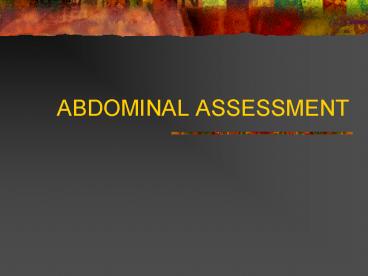ABDOMINAL ASSESSMENT - PowerPoint PPT Presentation
1 / 25
Title:
ABDOMINAL ASSESSMENT
Description:
ABDOMINAL ASSESSMENT Abdominal Assessment Patient needs to be exposed from above the xiphoid process to the symphysis pubis. Also, make sure your patient does not ... – PowerPoint PPT presentation
Number of Views:165
Avg rating:3.0/5.0
Title: ABDOMINAL ASSESSMENT
1
ABDOMINAL ASSESSMENT
2
Abdominal Assessment
- Patient needs to be exposed from above the
xiphoid process to the symphysis pubis. - Also, make sure your patient does not have a full
bladder. - Place patient in a supine position pillow under
the head and knees. - Helps to relax abdominal muscles.
3
Abdominal Assessment
- Have patient point out any areas of pain or
tenderness. - Examine these last.
- During exam continue to monitor your patients
facial expression for pain and discomfort. - Use inspection, auscultation, percussion, and
palpation to perform the exam.
4
Abdominal Assessment
- Always auscultate before percussing or palpating.
- These manipulations may alter your patients
bowel motility and resulting bowel sounds.
5
Abdominal Assessment
- Inspect the skin of the abdomen and flanks for
- Scars
- Dilated veins
- Stretch marks
- Rashes
- Lesions
- Pigmentation changes
6
Abdominal Assessment
- Look for discoloration over the umbilicus
- Cullens Sign discoloration over the umbilicus
- Grey Turners Sign discoloration over the
flanks - These are both late signs suggesting
intra-abdominal bleeding
7
Abdominal Assessment
- Assess the size and shape of your patients
abdomen to determine - Scaphoid (concave)
- Flat
- Round
- Distended
- Ask the patient if it is its usual size and shape
8
Abdominal Assessment
- Check for
- Bulges
- Hernias
- Distended Flanks
- Ascites appears as bulges in the flanks and
across the abdomen and indicates edema caused by
CHF, or liver failure.
9
Abdominal Assessment
- Look at your patients umbilicus
- Note location and contour and observe for any
signs of herniation or inflammation. - Check for
- Visible pulsation
- Visible peristalsis (wavelike motion of organs
moving their contents through the digestive
tract). May indicate bowel obstruction. - Visible masses
10
Abdominal Assessment
- Next auscultate for bowel sounds and other sounds
such as bruits throughout the abdomen. - Gently place the diaphragm on your patients
abdomen and proceed systematically, listening for
bowel sounds in each quadrant. - Note location, frequency, and character
- Normal bowel sounds consist of a variety of
high-pitched gurgles and clicks that occur every
5-15 seconds.
11
Abdominal Assessment
- More frequent sounds indicate increased bowel
motility in conditions such as diarrhea or an
early intestinal obstruction. - You may hear loud, prolonged, gurgling sounds
known as borborygmi. - These indicate hyperperistalsis.
- Decreased or absent sounds suggest a paralytic
ileus or peritonitis
12
Abdominal Assessment
- Bruits are swishing sounds that indicate
turbulent blood flow. - Listen in areas over abdominal blood vessels such
as the aorta and renal arteries - Presence indicates abdominal aortic aneurysm or
renal artery stenosis
13
Abdominal Quadrants Posterior
14
Abdominal Quadrants Anterior
15
Abdominal Assessment
- Percussing the abdomen produces different sounds
based on the underlying tissues. - Sounds help you detect excessive gas and solid or
fluid-filled masses - Also help you determine the size and position of
solid organs such as the liver and spleen - Percuss the abdomen in the same sequence you used
for auscultation
16
Abdominal Assessment
- Note the distribution of tympany and dullness
- Expect to hear tympany in most of the abdomen
- Expect dullness over the solid abdominal organs
such as the liver and spleen
17
Abdominal Assessment
- Palpate the abdomen last to detect
- Tenderness
- Muscular rigidity
- Superficial organs and masses
- Before you begin palpation, ask your patient if
he has any pain or tenderness - Palpate that area last, using gentle pressure
with a single finger
18
Abdominal Assessment
- Ask him to cough and tell you if and where he
experiences any pain - This is typical for peritoneal inflammation
19
Abdominal Assessment
- Light palpation by moving your hand slowly and
just lifting it off the skin. - Use same sequence as for auscultation and
percussion - Watch for patients face for signs of discomfort
20
Abdominal Assessment
- Identify any masses and note
- Size
- Location
- Contour
- Tenderness
- Pulsations
- Mobility
21
Abdominal Assessment
- Abdominal pain upon light palpation suggests
peritoneal irritation or inflammation - If rigidity or guarding while palpating,
determine whether it is voluntary (patient
anticipates the pain) or involuntary (peritoneal
inflammation)
22
Abdominal Assessment
- Next palpate deeply to detect large masses or
tenderness - Use one hand on top of another and push down
slowly. - Assess for rebound tenderness by pushing slowly
and then releasing your hand quickly off the
tender area.
23
Abdominal Assessment
- If you note a protruding abdomen with bulging
flanks and dull percussion sounds in dependent
areas, you might perform two tests for ascites.
24
Ascites/Test 1
- Assess for areas of tympany and dullness while
your patient is supine - Lie him on one side
- Percuss again, noting once more any areas of
tympany and dullness - If your patient has ascites, the area of dullness
will shift down to the dependent side and the
area of tympany will shift up.
25
Ascites/Test 2
- Test for fluid wave, ask an assistant to press
the edge of his hand firmly down the midline of
your patients abdomen - With your fingertips, tap one flank and feel for
the impulses transmission to the other flank
through excess fluid - If you detect the impulse easily, suspect ascites































